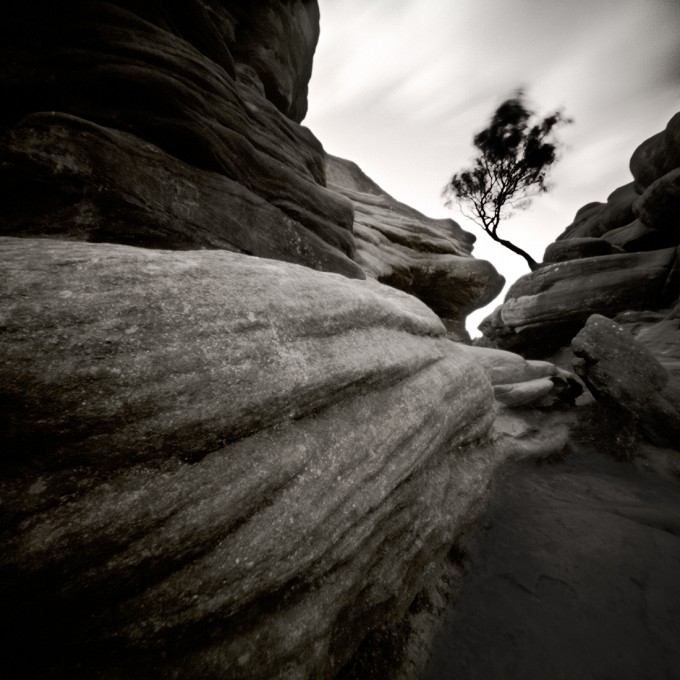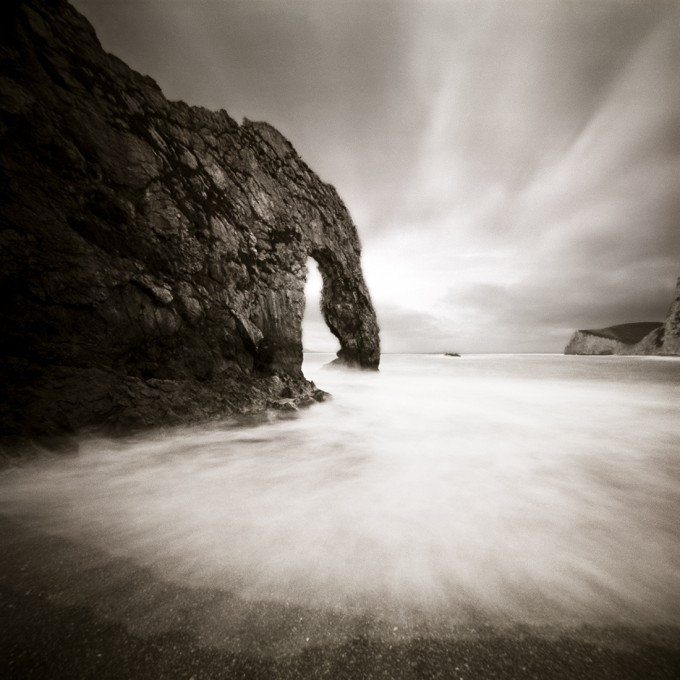Hope everyone had a great weekend! I want to start this Monday off with three very nice shots from Steve Gosling. These were shot on film in a very unique way. Read on to find out how. Be sure to visit Steve’s website HERE for more!
“Hi Steve
I hope that you are well and thanks for an interesting site – I visit every day.
Please find attached 3 photos taken on film (Ilford’s Pan F) on a Zero Image pinhole camera taken as part of my ongoing ‘Lensless Landscapes’ project. I’ve been working with pinhole cameras for a number of years and love the ethereal results possible due to unlimited depth of field, wide angle of view and very long exposures (from several seconds to many minutes e.g. the attached ‘Into the Light’ is a 40 minute exposure).
More recently I’ve been experimenting with pinhole adaptors on my Leica M6TTL and can’t wait to try them out on my recently acquired M9 (my dealer thinks I’m mad to spend £5k on an M9 and then use it as a pinhole camera! He’s right of course but then I will be using it to take ‘normal’ photos as well). One of the advantages of using a rangefinder camera for pinhole photography is that you can retain a reasonably wide angle of view (around 25mm with a full frame Leica compared to around 38mm with a DLSR). I’ll let you see some results from the M9 when I’ve had chance to test it out.
Many thanks and keep up the good work!
Best wishes
Steve Gosling”






Stunning work! As you say they sure are ethereal!!
Just : W-O-W !!!! Unbelievable shots !!! Bravo !!!
🙂 love your work, Steve !!! And now I´ll have to visit your homepage …
See you …
I don’t understand why my post has been deleted here!
Was I breaching any rules?
Ze
One word, gorgeous!
Thanks to everyone for your positive comments on my photographs – they are very much appreciated. If you’d like to see more of my pinhole landscapes then please visit – http://www.stevegoslingphotography.co.uk/portfolio-lensless-1.htm or http://www.stevegoslingphotography.co.uk/portfolio-lensless-2.htm
If anyone wants me to send them a couple of articles I’ve written for UK photo magazines on pinhole photography then please e-mail me via the link on the contacts page of my website – http://www.stevegoslingphotography.co.uk/contact.htm
I’ll try to answer your questions: –
Sheena – I try to avoid high contrast situations when I can and prefer shooting in overcast cloudy conditions. However the exposure latitude of B&W film does help me to retain highlight and shadow detail. As far as post processing is concerned I keep my work in Photoshop to a minimum – just doing what I would have previously done in a traditional darkroom e.g. controlling overall contrast, selectively dodging and burning, toning and sometimes diffusing the final print.
Richard Ford – for post processing please see above. I use 120 Pan F which is a very sharp film. But the Zero Image 2000 camera I use has a precision made pinhole and this helps with the sharpness; certainly sharper than any other adaptor/body cap device I’ve used so far. I use a Sekonic handheld spot meter for my exposure readings and allow 1 extra stop for reciprocity failure. These photos were taken with a pinhole camera – zone plates tend to give much softer, more highly diffused results.
Jason – you can get pinhole adaptors for Leica M cameras at http://www.leicagoodies.com/ or http://cgi.ebay.com/Skink-Pinhole-Pancake-Lens-Creative-Kit-Leica-M9-M8-MP-/290440321021?cmd=ViewItem&pt=Camera_Lenses&hash=item439f9797fd
Emily – I’m happy to answer any questions you have; just follow the link above to my contacts page.
Andy J – the shot was indeed taken in Dorset, at Durdle Door.
Thanks once again to everyone for the positive response to these.
Great shots Steve, love the creative effort 🙂 Is the last shot in Dorset? Looks familiar location to me…
jason says:
June 21, 2010 at 11:12 am
What’s the link for the pinhole to leica adapter?
Build one yourself! Pinhole cameras, or at least lenses, should be home made.
Here’s how to: #1. get the camera body plastic cover #2. drill a hole in the middle of it , anything from 5 to 15 mm diameter. #3. get an aluminum soft drink can or something similar. #4. cut out a piece about 25 mm diameter from the side of the can and flatten it. #5. and this is the only difficult part, make a very small round hole in the aluminum. the hole made by a needle is too large, just use the very end (sharp end) of the needle. # 6. use a good loupe to check that the hole is round and that the edges are sharp – if not try sandpapering the aluminum with the finest sanding paper you can get hold of and check again. perhaps have another go with the nail with do. a rough hole will result in very unsharp pictures #7. attach the aluminum to the outside of the camera body cover. use black duct tape or similar. the hole in the aluminum should be in the centre of the cover. #8 put the camera body cover on the camera. #9 start shooting, use built in exposure meter and 35 mm frames in the viewfinder. the rangefinder will not work ;=))
The focal length is about 35mm and the f-stop is easy to calculate. Measure the exposure of, say, a sunlit wall with a normal lens and note time and f-stop. It is convenient to use f/16 for the measurement. Then measure with the pin hole lens. See what time you get and calculate how many stops that is from the time measured for the f/16. The f-stop of your pinhole lens is as many steps from f/16 as the two measured times were apart. The f-stop range from 16 are 22 – 32 – 44 – 64 – 88 -128 – 176 – 256 and so on. A good pin hole lens should be in the region of 150 plus/minus one stop.
Sorry for the sloppy writing, but my battery is running low and I have to work fast.
I’ve heard of those pinhole cameras. They are wonderful. Now, these are the landscapes I love. This work is so beautiful. Thanks so much for taking the time to share these with us. This is the best work i’ve seen on here in a long time.
Awesome images! And, when you get the pinhole to work on the M9, please PLEASE share with with us. That sounds totally awesome, and I’d love to try it just for fun. This is when it’d be cool to have forums b/c I have lots of questions, or I’d like to swap emails.
Very inspiring! Thank you.
What’s the link for the pinhole to leica adapter?
Amazing mood to these images. Beautiful work.
Steve – did you use a zone plate or pin hole?
The reason I am all over this is that I have had this style of shot in my head for a while (not your style – an idea of mine) and I was thinking about 4×5 with a roll back or one of the shenhao 617 camera’s – then I realise that long exposures were also part of my idea and then a pin hole seems perfect – so it has brought back to the forefront this project of mine that I have had on hold for about 2 years….
Steve Gosling is featured here too! When I went looking for the nice metal pinhole/plate cameras that I have seen here:
http://www.zeroimage.com/
Mr Huff… please hurry up, place an order and get to the reviewing!! 🙂
man ive been wanting to build a pinhole 35mm camera for a long time and aquired all the materials, this might make me hurry it up a little bit. Beautiful images
This is fantastic. For all the talk about lenses and the special quality each one brings to the table, this work argues that no lens is better than any lens at all!!
Amazing photos. That’s the kind of inspirational stuff that’ll make ya drag the camera on a hike to try and capture the same magic as that guy. No, we probably can’t get close, but it makes us better for trying. Thanks for posting this!
wow, these are absolutely gorgeous!!! its amazing how much the simplest film-in-a-box can do for you when you’ve got the talent behind it.
just wow!
Excellent shots!
Did you dunk the negs in selenium or is this digital changes?
I like PAN F a lot and shoot it too. I have thought about a 120 format pin hole as they are very popular here in China and some very nice and very well made full metal ones are for sale – they like like flat 503SWM blads… with a little view finder on top.
Do you credit the PAN F with the better sharpness (compared to any other pin hole shot I have seen ever!!!) and is this in 120 or 135? And how do you calculate your exposures? And how is the reciprocity failure of PAN F?
Cheers,
RF.
Really lovely photos. I have an instant reaction, with a preference for #2 (I used to live in the Lake District in England), but going back and looking again at each, I cannot choose between them because each one could be looked at for a long time and I can be drawn into the picture, finding new things to see or just relax as if it were your surroundings.
Did you do any pp? I wonder what to expect with contrast, blown highlights etc. with so few controls. I’ve not done any pinhole work.
OMG at #2, Brilliant!
#2 is absolutely brilliant . Almost like a water color . Truly Inspirational work . Would love to try something similar on my yet to receive M9 .
Those landscapes are gorgeous. Deep, soft and full of atmosphere. #1 is my personal favorite. I’m curious to see such images taken with an M9. Perhaps the results will not look as delicious on digital.
Brilliant photos, amazing really that you make make photos like this with some film and a box with a hole in it. The last 2 in particular are great, I’d be delighted to have taken either of these.